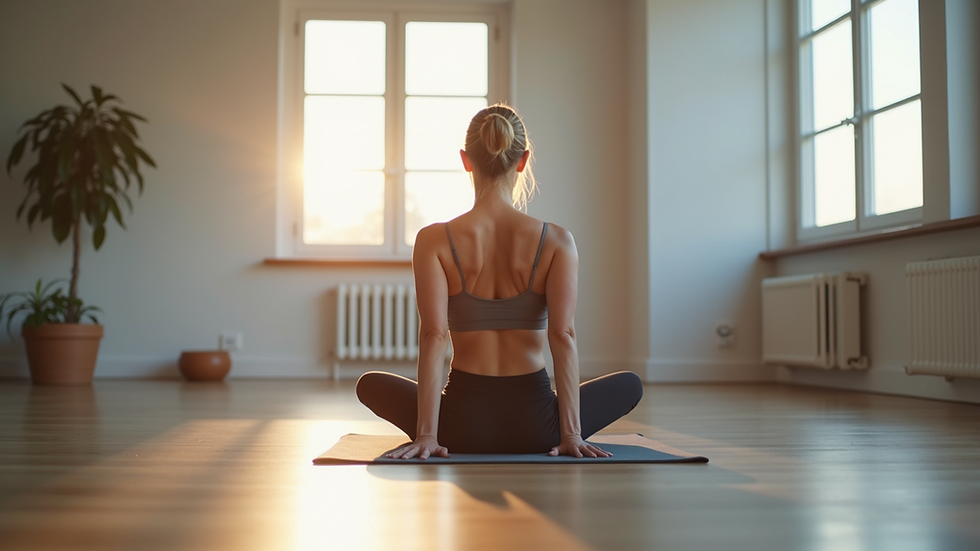Pilates Tips for Beginners: Master Your Practice
- Stacey Dawes

- Sep 18
- 5 min read
Pilates is a fantastic way to improve your strength, flexibility, and overall well-being. If you are new to Pilates, you might feel a bit overwhelmed. With so many exercises and techniques, where do you even start? Fear not! This guide is here to help you navigate your Pilates journey with ease.
In this post, we will cover essential tips for beginners, including how to set up your practice, key exercises to focus on, and common mistakes to avoid. By the end, you will feel more confident and ready to master your Pilates practice.
Understanding the Basics of Pilates
Before diving into the exercises, it is important to understand what Pilates is all about. Pilates is a low-impact exercise method that focuses on strengthening your core, improving posture, and enhancing flexibility. It was developed by Joseph Pilates in the early 20th century and has since gained popularity worldwide.
The core principles of Pilates include:
Concentration: Focus on your movements and breath.
Control: Perform each exercise with precision.
Centering: Engage your core muscles.
Flow: Move smoothly from one exercise to another.
Precision: Pay attention to detail in each movement.
Understanding these principles will help you get the most out of your practice.
Setting Up Your Practice Space
Creating a comfortable and inviting space for your Pilates practice is essential. Here are some tips to set up your area:
Choose a Quiet Space: Find a location where you can focus without distractions.
Use a Mat: A good quality Pilates mat provides cushioning and support.
Keep It Clean: A tidy space can help you feel more relaxed and focused.
Add Some Comfort: Consider using props like cushions or blocks to support your practice.
Good Lighting: Natural light can enhance your mood, so try to practice in a well-lit area.
By setting up a dedicated space, you will create a positive environment that encourages regular practice.
Essential Pilates Exercises for Beginners
Now that you have your space ready, let’s explore some key exercises to get you started. These foundational moves will help you build strength and improve your technique.
1. The Hundred
The Hundred is a classic Pilates exercise that warms up your body and engages your core.
How to Do It:
- Lie on your back with your legs in a tabletop position.
- Lift your head, neck, and shoulders off the mat.
- Extend your arms by your sides and pump them up and down while breathing in for five counts and out for five counts.
Tip: Keep your core engaged and avoid straining your neck.
2. Roll-Up
The Roll-Up is great for improving flexibility in your spine.
How to Do It:
- Lie flat on your back with your arms extended overhead.
- Inhale as you lift your arms and head off the mat.
- Exhale as you roll up to a seated position, reaching for your toes.
Tip: Move slowly and control your descent back to the mat.
3. Single Leg Stretch
This exercise targets your core and helps improve coordination.
How to Do It:
- Lie on your back with your knees pulled into your chest.
- Extend one leg while holding the other knee.
- Switch legs while keeping your head and shoulders lifted.
Tip: Focus on your breath and maintain a steady rhythm.
4. Plank
The Plank is a powerful exercise for building core strength.
How to Do It:
- Start in a push-up position with your hands under your shoulders.
- Keep your body in a straight line from head to heels.
- Hold the position for 20-30 seconds, focusing on your core.
Tip: Avoid letting your hips sag or rise too high.
5. Bridge
The Bridge strengthens your glutes and lower back.
How to Do It:
- Lie on your back with your knees bent and feet flat on the mat.
- Press through your heels to lift your hips toward the ceiling.
- Hold for a few seconds before lowering back down.
Tip: Squeeze your glutes at the top of the movement.
Common Mistakes to Avoid
As a beginner, it is easy to make mistakes that can hinder your progress. Here are some common pitfalls to watch out for:
Rushing Through Exercises: Take your time and focus on quality over quantity.
Neglecting Your Breath: Remember to breathe deeply and rhythmically throughout your practice.
Poor Alignment: Pay attention to your body position to avoid strain or injury.
Skipping the Warm-Up: Always start with a warm-up to prepare your muscles.
Ignoring Modifications: If an exercise feels too challenging, don’t hesitate to modify it to suit your level.
By being aware of these mistakes, you can enhance your practice and avoid unnecessary frustration.
Finding the Right Class or Instructor
If you prefer a guided experience, consider joining a Pilates class. Here are some tips for finding the right one:
Research Local Studios: Look for studios that offer beginner classes.
Check Instructor Credentials: Ensure that the instructor is certified and experienced.
Read Reviews: Look for feedback from other students to gauge the quality of the class.
Try a Trial Class: Many studios offer a free or discounted trial class. Take advantage of this to see if it’s a good fit.
Ask Questions: Don’t hesitate to reach out to the instructor with any concerns or questions.
Finding the right class can make a significant difference in your Pilates journey.
Incorporating Pilates into Your Routine
To truly master your practice, consistency is key. Here are some tips for incorporating Pilates into your daily routine:
Set a Schedule: Choose specific days and times for your practice.
Start Small: Aim for 15-20 minutes a few times a week and gradually increase the duration.
Mix It Up: Combine Pilates with other forms of exercise, like yoga or cardio, for a well-rounded routine.
Stay Motivated: Track your progress and celebrate small victories along the way.
Practice Mindfulness: Use your Pilates practice as a time to connect with your body and mind.
By making Pilates a regular part of your life, you will see improvements in your strength and flexibility.
The Importance of Listening to Your Body
As you embark on your Pilates journey, it is crucial to listen to your body. Here are some tips to help you stay in tune with your physical needs:
Know Your Limits: If an exercise feels too difficult or painful, modify it or take a break.
Rest When Needed: Allow your body time to recover, especially if you feel fatigued.
Stay Hydrated: Drink plenty of water before and after your practice.
Seek Professional Guidance: If you have any pre-existing conditions or injuries, consult a healthcare professional before starting Pilates.
Listening to your body will help you avoid injury and ensure a safe practice.
Building a Supportive Community
Connecting with others who share your interest in Pilates can enhance your experience. Here are some ways to build a supportive community:
Join Online Forums: Participate in online groups or forums dedicated to Pilates.
Attend Workshops: Look for workshops or events in your area to meet fellow enthusiasts.
Share Your Journey: Consider documenting your progress on social media to inspire others.
Partner Up: Find a friend or family member to join you in your practice.
Having a support system can keep you motivated and accountable.
Embracing the Journey
As you begin your Pilates practice, remember that it is a journey, not a destination. Embrace the process and be patient with yourself. Progress may come slowly, but with dedication and practice, you will see improvements over time.
Celebrate your achievements, no matter how small, and enjoy the benefits that Pilates brings to your life.

In the end, mastering your Pilates practice is about finding joy in movement and connecting with your body. So roll out your mat, breathe deeply, and enjoy every moment of your Pilates journey.


Comments